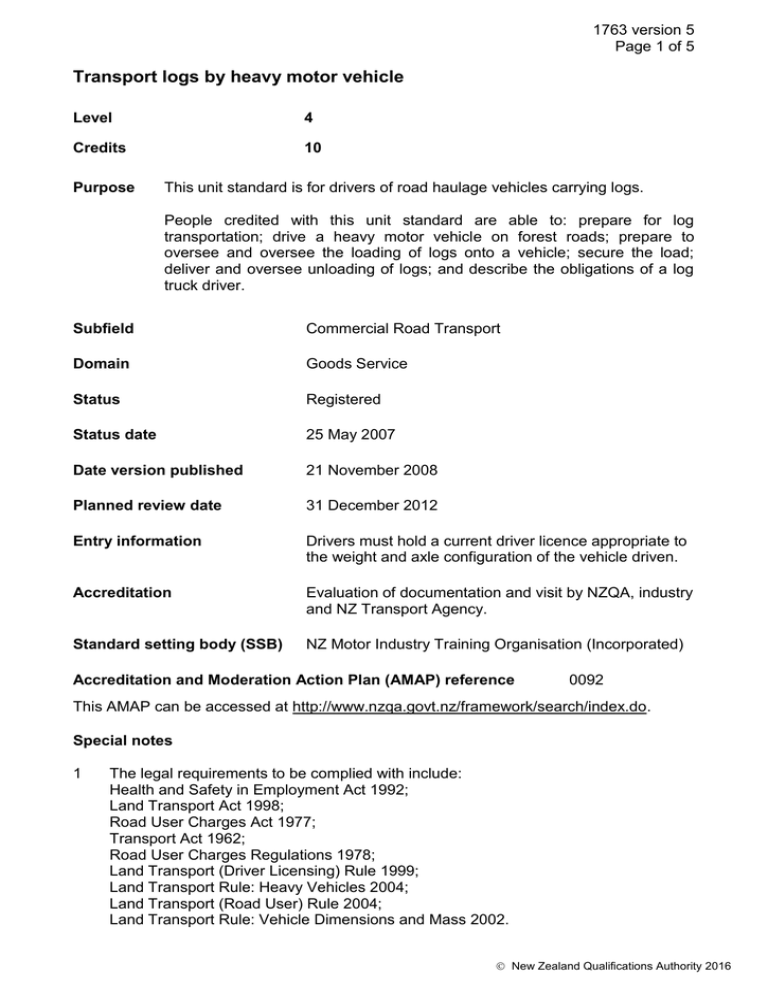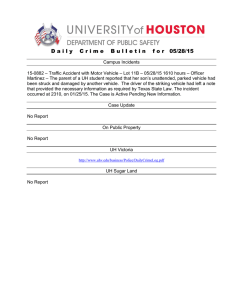Transport logs by heavy motor vehicle
advertisement

1763 version 5 Page 1 of 5 Transport logs by heavy motor vehicle Level 4 Credits 10 Purpose This unit standard is for drivers of road haulage vehicles carrying logs. People credited with this unit standard are able to: prepare for log transportation; drive a heavy motor vehicle on forest roads; prepare to oversee and oversee the loading of logs onto a vehicle; secure the load; deliver and oversee unloading of logs; and describe the obligations of a log truck driver. Subfield Commercial Road Transport Domain Goods Service Status Registered Status date 25 May 2007 Date version published 21 November 2008 Planned review date 31 December 2012 Entry information Drivers must hold a current driver licence appropriate to the weight and axle configuration of the vehicle driven. Accreditation Evaluation of documentation and visit by NZQA, industry and NZ Transport Agency. Standard setting body (SSB) NZ Motor Industry Training Organisation (Incorporated) Accreditation and Moderation Action Plan (AMAP) reference 0092 This AMAP can be accessed at http://www.nzqa.govt.nz/framework/search/index.do. Special notes 1 The legal requirements to be complied with include: Health and Safety in Employment Act 1992; Land Transport Act 1998; Road User Charges Act 1977; Transport Act 1962; Road User Charges Regulations 1978; Land Transport (Driver Licensing) Rule 1999; Land Transport Rule: Heavy Vehicles 2004; Land Transport (Road User) Rule 2004; Land Transport Rule: Vehicle Dimensions and Mass 2002. New Zealand Qualifications Authority 2016 1763 version 5 Page 2 of 5 2 Any new, amended or replacement Acts, regulations, Rules, standards, codes of practice, or NZ Transport Agency requirements or conditions affecting this unit standard will take precedence for assessment purposes, pending review of this unit standard. 3 Definitions the Approved Code of Practice refers to the Approved Code of Practice for Safety and Health in Forest Operations (Wellington: Occupational Safety and Health Service, Department of Labour, 1999) and any subsequent amendments. Available at http://www.osh.dol.govt.nz/order/catalogue/301.shtml; LTSC Industry Standards is a set of best practice guidelines and minimum legal requirements produced by the Log Transport Safety Council. Available from the LTSC, 127 Balmoral Drive, Tokoroa; organisational requirements include any legal requirements, standards, codes of practice, organisational and/or site requirements, industry best practice, and manufacturers’ instructions; positioning, in addition to positioning of the vehicle for loading and unloading, includes setting of equipment for the vehicle; the Truck Loading Code means The Official New Zealand Truck Loading Code – Code of Practice for the Safety of Loads on Heavy Vehicles (Wellington: Land transport New Zealand, current edition), available from booksellers. Elements and performance criteria Element 1 Prepare for log transportation. Performance criteria 1.1 Preparations ensure that the vehicle is equipped to meet the requirements of the Approved Code of Practice and organisational requirements. Range includes but is not limited to – tools, first aid equipment, fire extinguisher, securing devices, bolster attachments and locking devices. 1.2 Preparations ensure that protective clothing and equipment required by the Approved Code of Practice and organisational requirements are accessible. 1.3 Preparations include locating the loading site in terms of a navigable route to it, using maps, oral, or written instructions. 1.4 Preparation includes inspection of the vehicle to establish it meets legal requirements for heavy motor vehicles. New Zealand Qualifications Authority 2016 1763 version 5 Page 3 of 5 Element 2 Drive a heavy motor vehicle on forest roads. Performance criteria 2.1 Vehicle is driven on forest roads in accordance with the requirements of the Approved Code of Practice and forest owner. Element 3 Prepare to oversee the loading of logs onto a vehicle. Performance criteria 3.1 Preparations include establishing communications with the loader operator and positioning the vehicle for loading in accordance with the directions of the loader operator and organisational requirements. 3.2 Preparations include wearing protective clothing and equipment at all stages of loading operations in accordance with the Approved Code of Practice. 3.3 Preparations include unloading the trailer from the truck and hooking it on with all brake and electrical connections made in accordance with LTSC Industry Standards. 3.4 Preparations include positioning and parking the vehicle with required park brakes applied in accordance with organisational requirements. Element 4 Oversee the loading of logs onto a vehicle. Performance criteria 4.1 Log movement and loading is directed from a safe position in accordance with the Approved Code of Practice and LTSC Industry Standards. 4.2 Communication with the loader operator ensures that the correct product is selected and positioned correctly on the vehicle. 4.3 Load is assessed for weight, height, and length in accordance with legal requirements and LTSC Industry Standards. Range 4.4 weight assessment may include – using on-board scales. Documentation is completed to the requirements of the transport company and forest owner. New Zealand Qualifications Authority 2016 1763 version 5 Page 4 of 5 Element 5 Secure the load. Performance criteria 5.1 Load securing devices are attached and the load is secured in accordance with LTSC Industry Standards. 5.2 Load and vehicle are checked to ensure there is no loose debris in accordance with LTSC Industry Standards. 5.3 Load security and tension of load restraints are re-checked before vehicle is driven on public roads. Element 6 Deliver and oversee unloading of logs. Performance criteria 6.1 The vehicle is driven on public roads in accordance with legal requirements and in a manner that is consistent with the load. 6.2 Unloading operations meet the requirements of LTSC Industry Standards. 6.3 Load delivery is within the customer’s time requirement. 6.4 Documentation is handled to the requirements of the transport operator, forest owner, and customer. 6.5 If required, the trailer is loaded onto the truck following unloading in accordance with LTSC Industry Standards. Element 7 Describe the obligations of a log truck driver. Performance criteria 7.1 The driver’s responsibilities for weight of laden log transport vehicles, and the consequences of overloading, are described in terms of the obligations under the legislation and in accordance with the Truck Loading Code. Range 7.2 may include responsibilities specific to 22 metre requirements. Information that must be entered on log load documentation is identified in accordance with the requirements of the harvesting contractor, loader operator, log transport operator, weighbridge operator, and customer. New Zealand Qualifications Authority 2016 1763 version 5 Page 5 of 5 Please note Providers must be accredited by NZQA, or an inter-institutional body with delegated authority for quality assurance, before they can report credits from assessment against unit standards or deliver courses of study leading to that assessment. Industry Training Organisations must be accredited by NZQA before they can register credits from assessment against unit standards. Accredited providers and Industry Training Organisations assessing against unit standards must engage with the moderation system that applies to those standards. Accreditation requirements and an outline of the moderation system that applies to this standard are outlined in the Accreditation and Moderation Action Plan (AMAP). The AMAP also includes useful information about special requirements for organisations wishing to develop education and training programmes, such as minimum qualifications for tutors and assessors, and special resource requirements. Comments on this unit standard Please contact NZ Motor Industry Training Organisation (Incorporated) info@mito.org.nz if you wish to suggest changes to the content of this unit standard. New Zealand Qualifications Authority 2016
